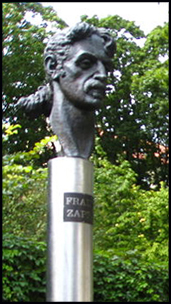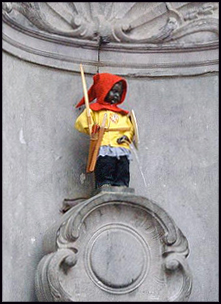 By PAT HARTMAN
By PAT HARTMAN
News Editor
Eric Slick is a percussionist with the Adrian Belew Power Trio and Crescent Moon, among others. Most recently, he was part of Project Object, the brainchild of Ike Willis and Don Preston, bringing the music of Frank Zappa to European fans — specifically in the Czech Republic, the Netherlands, Spain, and Germany. Eric shares with us the sensations and adventures of a musician on tour:
We’re on the way to one of my favorite places in the whole world. a quaint village called Bad Doberan, the home of Zappanale, a week long festival dedicated to the genius of Frank Zappa: composer, filmmaker, guitarist, politician, iconoclast. It’s as close as I’ve come to some form of heaven.
Indeed this drummer compares Zappanale to such ideal locales as Mecca and Utopia and, having participated at 5 successive yearly recurrences, he ought to know. He admires the efficient organization behind the festival, and is especially enthusiastic over the addition this year of a second stage. He tells us — dare we believe it? — that the last band on the last night played “Girls Just Wanna Have Fun” in the nude.
No doubt about it, Zappa is alive and well on the Continent. Only last month, at Spiegel Online, journalist Sebastian Knauer interviewed Napoleon Murphy Brock. Brock, who is a vocalist, saxophonist, flautist and comedian, is one of the Zappa friends who ensure that the great one’s work does not fall into oblivion. This apparently brings him into opposition with the widow and guardian of the estate, Gail Zappa. Brock points out here that “her husband collected inspiration from all styles of music and interpreters and was himself a great plagiarist, before making something entirely his own.” He talks about the “Zappa College,” the fresh generation of youth who are discovering and treasuring the music of Frank Zappa, represented by 19 bands at the Bad Doberan event. He especially likes an old-time railway there, called Molli, and says, “Frank would have done a song about that.”
 Vilnius, Lithuania, is another outpost of Zappa-consciousness, as proven by the erection of a statue there in 1995 and visited by Kevin Dolgin, who assures us in The Third Tower Up From the Road that “Zappa never had anything to do with Vilnius, never set foot in Lithuania, and had not a smidgen of Lithuanian heritage.” But who cares? What matters is the power of music to foster international brotherhood, which it surely does in this case. Konstantinas Bogdanas is the sculptor, who must have felt some relief after spending, as Kevin tells us, “something like 50 years sculpting Soviet political leaders.” Earlier this year, a bronze replica of the Kalinausko Square statue in Vilnius was made and given to the American city of Baltimore, Zappa’s home town.
Vilnius, Lithuania, is another outpost of Zappa-consciousness, as proven by the erection of a statue there in 1995 and visited by Kevin Dolgin, who assures us in The Third Tower Up From the Road that “Zappa never had anything to do with Vilnius, never set foot in Lithuania, and had not a smidgen of Lithuanian heritage.” But who cares? What matters is the power of music to foster international brotherhood, which it surely does in this case. Konstantinas Bogdanas is the sculptor, who must have felt some relief after spending, as Kevin tells us, “something like 50 years sculpting Soviet political leaders.” Earlier this year, a bronze replica of the Kalinausko Square statue in Vilnius was made and given to the American city of Baltimore, Zappa’s home town.
Please send us other evidence of Zappa infiltration into Europe!
In related news, Daniel Cook Johnson enthuses over the new 35MM film release of Zappa’s 1971 classic 200 Motels, which also features Ringo Starr as a dwarf and Keith Moon as a nun. Johnson characterizes the movie as “a mess by design” and reminds us of its historical significance as the first feature-length film shot on videotape.
And at Guba, someone has posted a 1986 episode of the TV talk show “Crossfire” where Zappa appears in short hair and a suit, discussing important matters.
photo courtesy of Wikimedia Commons.

 By PAT HARTMAN
By PAT HARTMAN